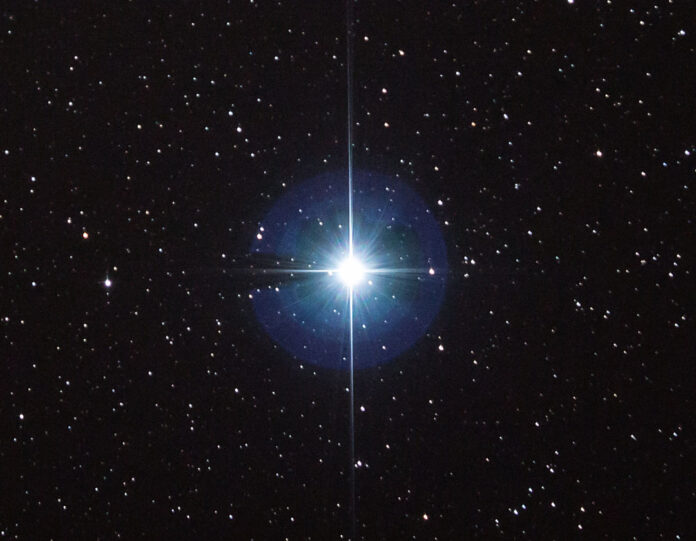Vega is the brightest star in the constellation of Lyra and the fifth brightest overall known to us. In the Northern Hemisphere, it is surpassed in brightness only by Arcturus. Its name comes from the Arabic word “waqi,” meaning “falling eagle.” This is because to the Ancient Egyptians, the constellation of Lyra appeared as a griffin or an eagle.
For a long time, Vega was used as a standard for calibrating telescopic instruments and has earned the nickname “the most important star after the Sun” among astronomers. Vega can be seen from almost any point on Earth, except Antarctica and the southern tip of South America. It is best observed during the summer – in July, when the conditions for observing the summer-autumn asterism (triangle) are optimal, with Vega being the top point.
Main Characteristics
- Vega is a prototype of “infrared stars” (stars with a disk of dust and gas, which emits light in the infrared range under the influence of the star’s energy).
- The mass of this protoplanetary disk is approximately equal to 12 times the mass of Jupiter and about 2.2 times the mass of the Sun.
- Vega’s age is about 460 million years.
- Distance from the Solar System: 7.67 parsecs (25 light-years).
- Radius: about 2.73 solar radii, with the polar radius of the star being smaller than the equatorial radius (2.36 versus 2.82).
- Surface temperature: about 9300 degrees Celsius, although it is not uniform everywhere and is much lower at the equator.
- The star rotates on its axis extremely quickly, at about 230 km/s (the Sun’s rotational speed is slightly over 2 km/s). This rapid rotation gives Vega an ellipsoidal shape.
Luminosity
Astronomers’ calculations indicate that Vega is slowly but steadily approaching the Solar System. Currently, it is only fifth in brightness, but in 210,000 years, it will become the brightest visible star and will remain so for another 250-270,000 years.
Vega’s luminosity is about 37 times that of the Sun and has slightly variable brightness. It is also one of the brightest stars within a radius of 10 parsecs from the Sun.
X-ray radiation from the star is comparatively insignificant compared to other stars, possibly due to the absence or weakness of its corona. Vega is powered by the synthesis of helium from hydrogen.
Interesting Facts about Vega:
- Vega differs from most stars in its ellipsoidal shape.
- Vega holds the record among stars in:
being photographed with telescopes (1850);
determining the emission spectrum (1872);
establishing distance by the method of parallax (1837);
discovering a dust disk (1983). - For many years, it served as the zero point (a star with zero apparent magnitude) for measuring the radiation of other stars, known as stellar magnitudes.
- Heavy metals in the star’s composition make up only 0.54% (Vega is believed to have formed from a hydrogen cloud with a lack of metals and cosmic dust).
- There is a possibility of another planet the size of Neptune near Vega, as well as the presence of a satellite around the star. However, this cannot be definitively observed even with the most powerful telescopes due to the star’s high brightness and its distance from the Solar System.
- Vega never crosses the visible horizon of the Northern Hemisphere.
- Vega is the apex of the “Summer Triangle,” which includes Deneb and Altair. The triangle serves as a landmark for simplifying the search for other summer constellations in the sky. The Milky Way passes through it.
- Vega’s system was the source of a signal in the extraterrestrial communication in the science fiction film “Contact.” The star is generally beloved by authors of science fiction literature.
- It is one of the 15 selected stars, according to medieval astrologers, exerting the greatest influence on humanity.
- The estimated lifespan of Vega is 1 billion years with the further perspective of transforming into a red giant and then into a white dwarf.
